Physical Address
304 North Cardinal St.
Dorchester Center, MA 02124
Adenocarcinoma in situ (AIS), like its invasive counterpart, has increased in incidence over the past 30 years. The median and mean patient ages are in the fourth decade, 10–15 years lower than those with invasive adenocarcinoma. Women with intestinal-type AIS are a decade older than those with typical (endocervical-type) AIS (mean ages 45 years vs 34 years, Howitt et al.).
~20% of patients have a history of a SIL, and AIS is often found incidentally in specimens containing a SIL.
There is almost always an abnormal Pap smear, with dysplastic glandular cells, dysplastic squamous cells, or both. Re-review of smears may increase the frequency of detection of atypical glandular cells.
AIS may be seen colposcopically, but there is no diagnostic appearance and in some cases a colposcopic abnormality is due to synchronous SIL.
AIS usually contains HRHPV (often HPV 18), exceptions being the intestinal and gastric types that are typically unrelated to HPV (see below).
AIS typically occurs within 1 cm of the squamocolumnar junction, and is multifocal in 10–15% of cases and characteristically involves both surface and glandular epithelia. It is usually recognizable on low-power examination. Rarely AIS extends into the endometrium.
AIS-involved glands are often admixed with and have the distribution and configuration of non-neoplastic glands, including those with an irregular contour or cystic or clustered. AIS can involve otherwise benign processes such as papillary endocervicitis or tunnel clusters.
Pseudostratified or stratified columnar cells with malignant nuclear features focally replace the surface or glandular epithelium, the latter often with an intraluminal cribriform or solid pattern. The AIS cells may also line intraglandular or surface papillae.
Lesional cells have moderate amounts of juxtaluminal cytoplasm with variable amounts of mucin, although the latter is diminished compared to normal endocervical cells.
Enlarged, fusiform, variably hyperchromatic nuclei are oriented perpendicular to the lumen and have fine to coarse chromatin and prominent nucleoli. Normal and abnormal mitotic figures, which are often juxtaluminal, are almost always present and usually numerous, as are apoptotic bodies.
There is typically strong diffuse p16 positivity (reflecting HRHPV), positivity for Ki-67 and CEA, and loss of ER/PR and vimentin.
AIS confined to the surface epithelium and/or gland openings, which may be overlooked, was found in women a decade younger than those with typical AIS, suggesting it may be an early form of AIS (Witkiewicz et al.).
Unlike typical AIS, these lesions exhibited variable (sometimes only mild) atypia and rare to absent apoptotic bodies.
Like typical AIS, the lesional cells exhibit hyperchromasia, mitotic activity, Ki-67 staining of >40%, p16 positivity, and an integrated pattern of HPV.
AIS is associated with SIL in >50% of cases, and when the latter is extensive, the AIS may be overlooked. When either lesion is present, the other should be looked for.
Uncommon subtypes of AIS resemble their invasive counterparts (see separate headings).
Intestinal type. Mucin-rich goblet cells (and occasional argentaffin and Paneth cells) contain intestinal-type sialomucins. The mucin can compress and flatten the nucleus obscuring its malignant features. Goblet cells in endocervical glands favor intestinal-type AIS given the rarity of benign endocervical intestinal metaplasia ( Chapter 4 ). The cells are CDX2+ and have less intense staining for p16 and Ki-67 than in usual AIS.
HSIL with prominent cytoplasmic mucin (‘stratified mucin-producing intraepithelial lesion’ or SMILE) ( , Onishi et al.). The cells may resemble goblet or signet-ring cells (Sano et al.). SMILEs are p16+/CAM 5.2+/p63− (or focally +) (Onishi et al.). Boyle and McCluggage found that SMILE coexisted with HSIL, AIS, and carcinoma in 93%, 42%, and 10% of cases respectively.
Gastric variant. This may co-exist with lobular endocervical glandular hyperplasia (see Chapter 4 ). Glands are lined by variably stratified columnar cells that may form intraglandular papillae. The cells have abundant usually eosinophilic to pale pink (or occasionally foamy or clear) cytoplasm; goblet cells may also be present. Nuclear atypia is usually mild but nucleoli may be prominent; mitoses and apoptotic bodies are less frequent than in typical AIS. There is non-block p16 staining and usual negativity for ER and PR. Other variably positive markers include HIK1083, MUC6, CK7, CK20, CDX2, PAX8, and CEA. Overexpression of p53 may be seen. Occasionally the process involves the lower uterine segment or even the endometrium.
Rare reported variants include adenosquamous carcinoma in situ, endometrioid, ciliated, serous, clear cell, and glassy cell, but convincing examples of the latter five are very rare in our experience.
Synchronous lesions (other than SILs) include endocervical glandular dysplasia (see below), microinvasive or invasive adenocarcinoma, and ISqCC or adenosquamous carcinoma. AIS may spread to the endometrium and ovary, potentially mimicking primary tumors in these sites. Ovarian involvement has a more favorable prognosis than with ovarian metastases from an invasive endocervical adenocarcinoma ( Chapter 18 ).
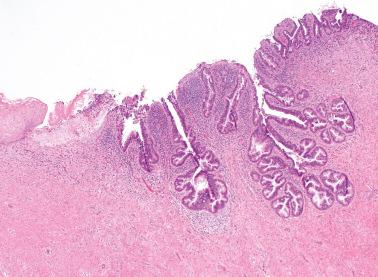
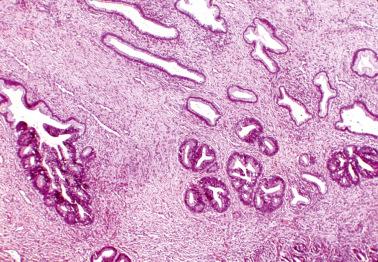
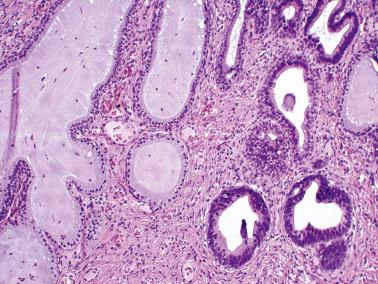
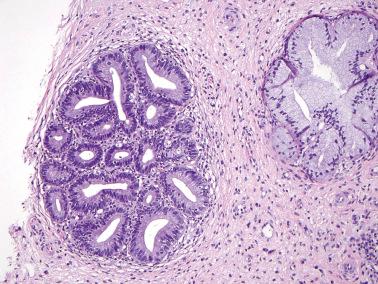
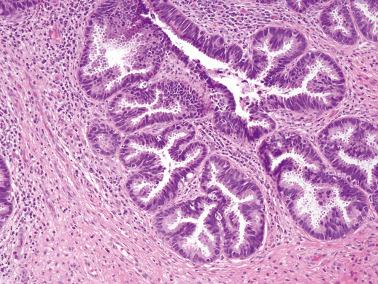
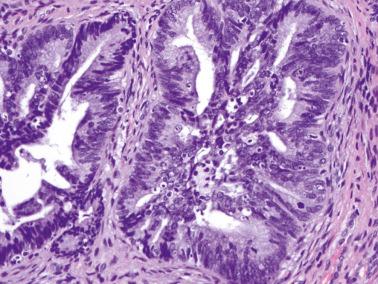
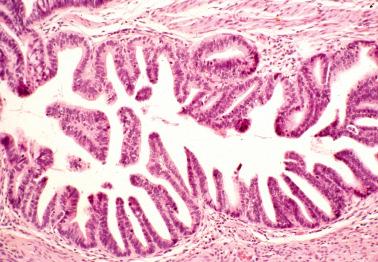
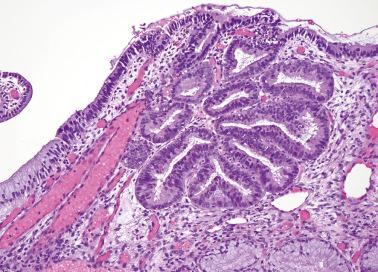
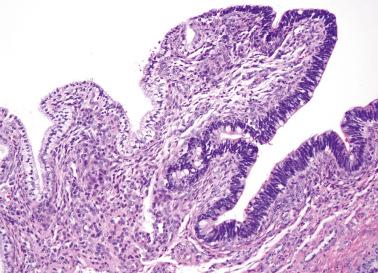
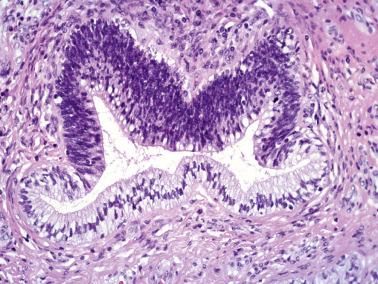
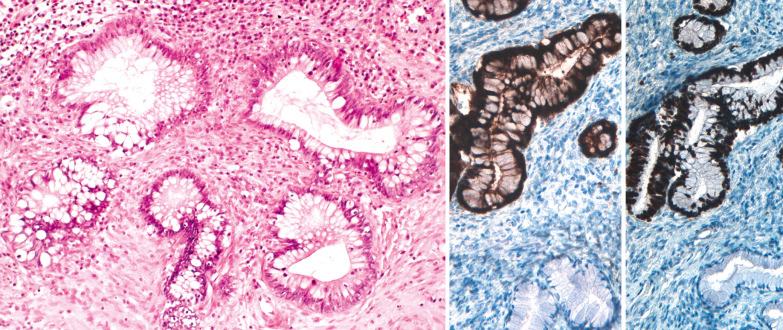
Endocervical glandular dysplasia (see corresponding heading) and a variety of non-neoplastic glandular lesions (see differential features in Chapter 4 ), including tubal and tuboendometrioid metaplasia, endometriosis, atypical oxyphilic metaplasia, reactive atypia, Arias-Stella reaction, radiation-induced atypia, and cautery artifact. These lesions lack the usually diffuse high-grade atypia, brisk mitotic activity, numerous apoptotic bodies, and strong diffuse Ki-67 and p16 staining of AIS.
Early invasive adenocarcinoma (see below).
Secondary adenocarcinomas.
Mucosal extension of an endometrial adenocarcinoma (see Adenocarcinomas of Usual Type, Differential Diagnosis ).
Endocervical implantation (via transtubal spread) of an extrauterine adenocarcinoma, most commonly serous carcinoma. Awareness of the presence of the latter, its distinctive microscopic features and immunoprofile (WT1+/ p53+, variable ER/PR positivity, and absence of HPV) point to the correct diagnosis.
Positive margins in cone biopsy or LEEP specimens markedly increase the risk of recurrence, but even negative margins are associated with recurrent abnormal cytology, AIS, or SILs in up to 15% of cases. , however, found lower recurrence risks with negative margins with recurrent HSIL, AIS, and invasive adenocarcinoma in 1.9%, 2.8%, and 0.3% respectively.
Factors increasing recurrence risk include age >30 years, pure AIS lesions, lesions >8 mm, and detection of HRHPV during follow-up (Costa et al., Munro et al., 2017a).
Rare cases of cervical AIS have recurred in the vagina as AIS or invasive adenocarcinoma, sometimes years later.
EGD (aka low-grade cervical glandular intraepithelial neoplasia) refers to a spectrum of dysplastic changes that are less severe than those of AIS. Its clinical and pathologic features are poorly characterized, some investigators doubting the existence of a precancerous endocervical glandular lesion lacking the features of AIS.
Lee et al. found EGD in 7% of their specimens of AIS and/or invasive adenocarcinoma, whereas Goldstein et al. found no EGD in 57 similar cases. These differences are almost certainly related to differing diagnostic thresholds for EGD vs AIS.
The minimal criteria for EGD proposed by Jaworski include nuclear atypia and evidence of cellular proliferation in the form of occasional mitotic figures and apoptotic bodies. Some authors have subdivided EGD into low- and high-grade EGD, but the distinction of low-grade EGD vs reactive atypias and the distinction of high-grade EGD vs AIS is subjective and of unproven clinical utility.
We rarely diagnose EGD as most cases referred with this diagnosis can be categorized as a benign lesion (reactive atypia, tuboendometrioid metaplasia, endometriosis) or as typical or subtle (‘early’) AIS (see above).
The mean age and age range are similar to those of AIS. Atypical columnar cells in Pap smears are present in some cases.
Some EGDs are HPV+, especially when synchronous with AIS or HSIL. p16, ProEX C, and MIB1 staining may be present, but is usually more focal and weak than in AIS. Strong diffuse staining for p16 and MIB1 may help identify lesions that harbor HRHPV and thus likely biologically equivalent to AIS.
Stage IA adenocarcinoma (EIA) is usually defined by a tumor depth of invasion of <5 mm and a breadth of <7 mm. Others suggest a size of <500 mm 3 , requiring assessment of three dimensions. EIAs can be subdivided into stage IA1 and IA2 lesions as in squamous lesions. Most EIAs are associated with synchronous AIS, which may be extensive.
The mean age (39–44 years) is intermediate between that of patients with AIS and those with clinically invasive adenocarcinoma. Patients are often asymptomatic or occasionally have postcoital bleeding. Colposcopic findings only rarely suggest early invasion. The Pap smear findings are similar to those of AIS.
EIA usually appears as aggregates of malignant glands resembling those of AIS except for a more haphazard, crowded, or focally confluent arrangement. The distinction between EIA and extensive AIS may be difficult.
Cribriform and papillary patterns are more common than in AIS, but are not diagnostic.
Helpful findings, although not always present, include one or more of: a reactive stroma, glands extending deeper than the normal glands, glands adjacent to thick-walled blood vessels, and lymphatic invasion.
found that cytoplasmic staining for laminin-5 at the invasive front facilitated recognition of early invasion.
Jordan et al. found that a desmoplastic stromal response (an increased intensity and number of SMA+ periglandular stromal cells) favored early invasion: AIS had 18% SMA+ cells vs 44% in EIA.
EIA less commonly is more obviously infiltrative with irregular bud-like projections, small glands, or solid nests of cells, sometimes with a stromal reaction. The invasive cells resemble those of AIS, or occasionally have eosinophilic cytoplasm.
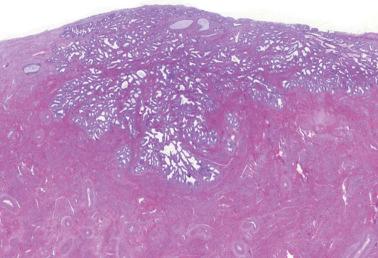
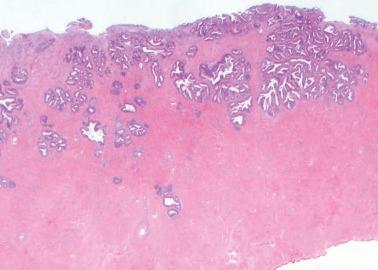
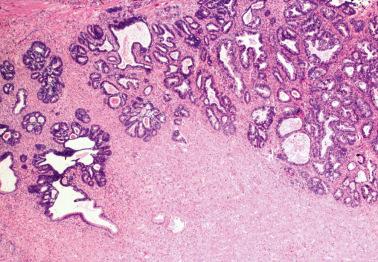
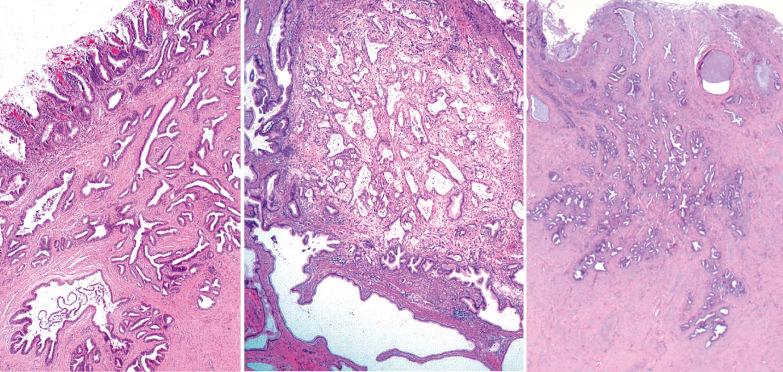
EIA has an excellent prognosis when treated by simple hysterectomy or cone biopsy with or without pelvic lymphadenectomy.
Smith et al. found no survival differences for stage IA1 and IA2 tumors (both ~98%). A literature review (Poynor et al.) found that 0.8% of patients with IA1 and 1.7% of IA2 tumors had nodal spread.
Ceballos et al. found that none of 55 stage IA1 or IA2 tumors had lymphatic invasion, nodal metastases, or recurrences, but 11% of those undergoing lymphadenectomy had long-term complications favoring conservative surgical procedure in this population.
In contrast, Diaz De Vivar et al. found that some IA tumors with early or diffuse destructive invasion (single cell invasion, desmoplasia) were associated with LVI and nodal spread, suggesting that the tumor's invasive pattern is more important than its size or depth. This and other studies dealing with patterns of invasion are considered in more detail below (see Invasive Adenocarcinomas: Classification, invasive patterns, and prognostic features ).
Ronnett et al. described rare EIAs with spread to the endometrium or ovary, possibly due to retrograde transtubal spread. The ovarian involvement may mimic a primary ovarian tumor ( Chapter 18 ).
( Table 6.1 )
|
These tumors now account for ~25% of cervical carcinomas compared to <10% 30 years ago, due to a true increased frequency and a decrease in ISqCCs. The mean age is between 44 and 54 years, but the proportion in those <35 years of age has increased.
HPV (usually types 16 or 18) is typically found in endocervical adenocarcinomas of usual type. Less common subtypes (even if p16+) that are almost invariably HPV− include gastric-type, clear cell, and mesonephric adenocarcinomas.
Abnormal bleeding is typical; occasionally there is vaginal discharge, pain, or an abnormal Pap smear. A polypoid or sessile mass is present in 80% of cases. Others have little or no mucosal abnormality but diffusely thicken the cervical wall. Occasionally, a frankly invasive tumor has little or no perceptible gross abnormality.
Rare presentations include:
Ovarian metastases, which may mimic a primary ovarian tumor. The cervical tumor may be only superficially invasive or exhibit no obvious invasion ( Chapter 18 ).
Prominent endometrial or endomyometrial involvement.
Trousseau's syndrome. Systemic thromboembolism has led to the discovery of a high-stage cervical adenocarcinoma, occasionally with signet-ring cell differentiation.
Leukocytosis related to paraneoplastic colony-stimulating factor production.
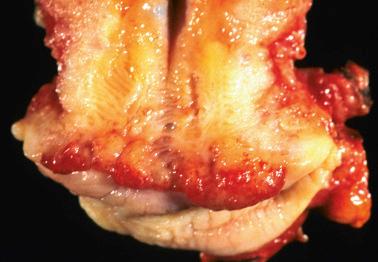
Endocervical adenocarcinomas are subdivided by cell type (see Table 6.1 ). Mixed tumors contain >1 subtype in which the minor component accounts for ≥10% of the neoplasm with an indication of the proportion of each subtype. Most are of usual type and are considered here.
Typical findings include:
The tumors are usually moderately differentiated with medium-sized glands lined by stratified columnar cells with eosinophilic to amphophilic cytoplasm and moderate to severe nuclear pleomorphism, findings that may create a pseudoendometrioid appearance. Mitotic figures and apoptotic bodies are usually numerous. Synchronous AIS and/or SILs are commonly present.
Although often referred to, particularly in the past, as ‘mucinous’, these tumors usually lack conspicuous cytoplasmic mucin, although mucin staining may reveal sparse mucin in the apical cytoplasm and gland lumens. Mucinous tumors with prominent cytoplasmic mucin (including those of gastric type) are considered under a separate heading.
The neoplastic glands are widely spaced to closely packed. Irregular, angulated, and branching glands and a focal cribriform pattern are common. Other patterns can include a focal lobular pattern, poorly differentiated solid areas, and small clusters and single cells. A stromal reaction may be absent or conspicuous.
Uncommon to rare findings, some of which can cause diagnostic problems include:
A prominent villous or villoglandular pattern on the surface and/or within gland lumens.
A micropapillary pattern. found this to be an uncommon focal (≤25% of the tumor) finding in which the constituent cells formed small nests. The latter had ‘inside-out’ (reversed) polarity of the cells with MUC1 expression at the cell membranes abutting the stroma rather than the usual apical staining.
A microglandular pattern resembling that of microglandular hyperplasia.
A prominent microcystic pattern with numerous, variably sized, cystic glands lined by flattened cells (that may be focally denuded) and low-grade nuclear features, resulting in a deceptively benign appearance.
Patterns resembling those of lobular breast carcinoma with bland epithelial cells in diffuse, small glandular, trabecular, and single-file patterns and cells with intracytoplasmic lumina.
Prominent choriocarcinomatous and/or hepatoid differentiation.
Extension of the tumor into the endometrium, myometrium, or both.
Based on the degree of nuclear atypia and mitotic activity, most tumors are moderately differentiated (grade 2 of 3). Under-diagnosing uniformly glandular tumors as well differentiated can incorrectly imply a favorable prognosis and may lead to inadequate treatment.
Immunostains are not usually required for routine diagnosis. The tumor cells typically show diffuse strong positivity for p16 reflecting the presence of HRHPV. As ~30% of the most common endocervical adenocarcinomas are PAX8−, a PAX8− metastatic adenocarcinoma could be of cervical origin. Other immunohistochemical findings are noted under Differential Diagnosis.
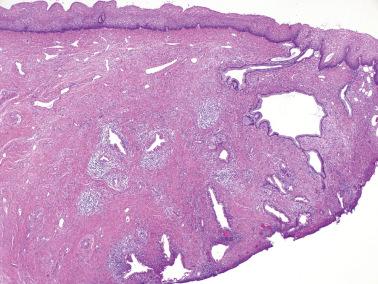
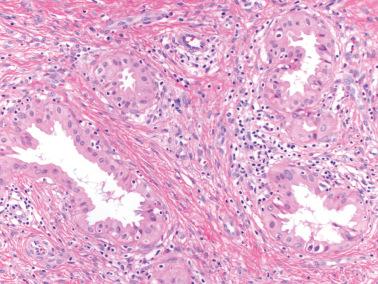
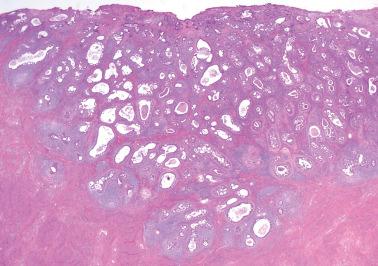
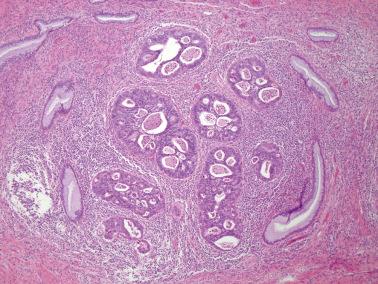
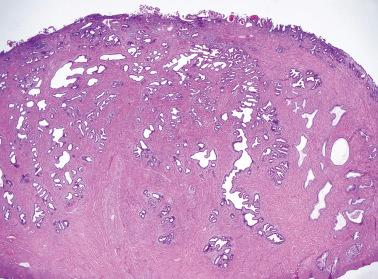
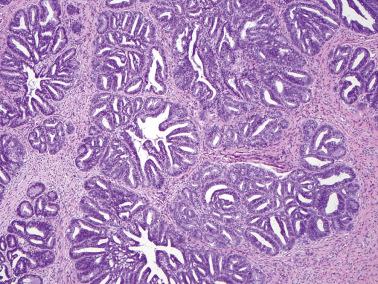

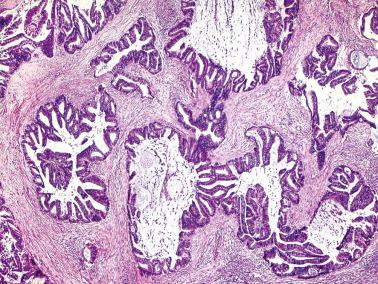
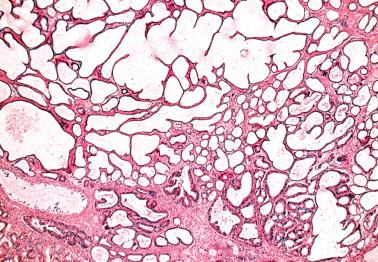
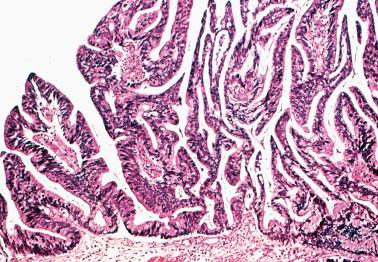
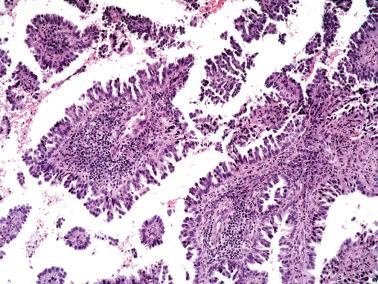
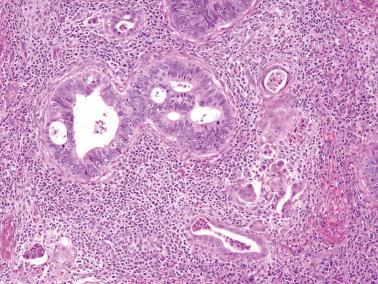
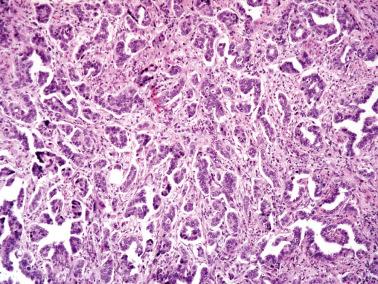
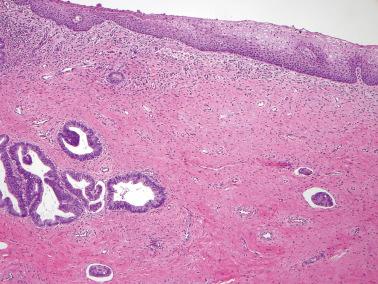
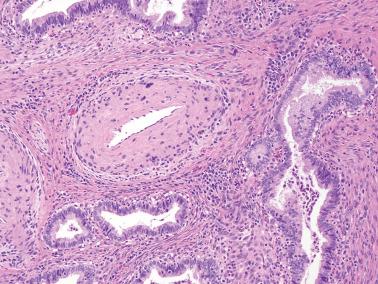
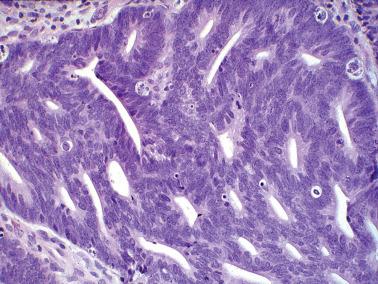
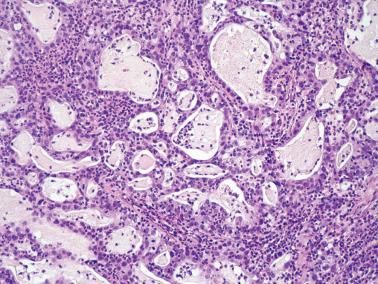
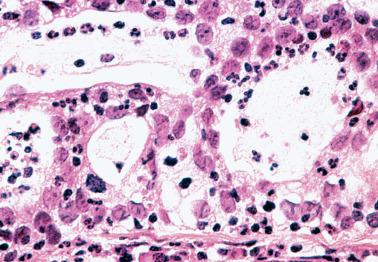
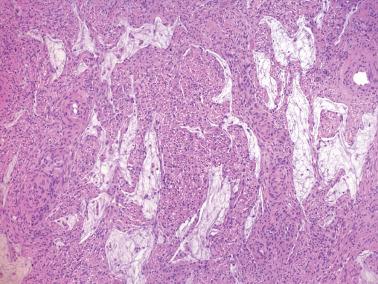
The most important clinical prognostic factors are clinical stage and lymph node status.
Pathologic prognostic factors:
These include tumor size (tumors <3 cm have an 88–97% survival vs. 50–62% for tumors 4–5 cm); tumor depth; histologic subtype; invasive pattern (see below); presence or absence of lymphatic, blood vessel, and paracervical tissue invasion; and status of resection margins and any submitted lymph nodes.
Stany et al. found that nodal micrometastases (single cells or small groups of CAM 5.2/AE1+ cells) did not impact prognosis.
No consensus exists on grading criteria or the impact of grade on prognosis, an observation likely due at least in part to the similarity of grade of most usual-type endocervical adenocarcinomas (if invasive patterns are excluded), few being well differentiated and few being poorly differentiated.
Silva and coworkers (Diaz De Vivar et al., Roma et al.[2015]) delineated three invasive patterns (requiring the tumor's complete histologic examination) that better predict risk of nodal spread and behavior than depth of invasion, and stratifies patients with stage I and II tumors into three distinct groups.
Group A. Tumors with a ‘well-demarcated gland’ pattern (21% of cases) with a pushing pattern of invasion and without the features of destructive invasion in groups B and C tumors, i.e. high-grade cytologic features, solid foci, confluent (>5 mm) papillary patterns, infiltrative borders, single cell invasion, desmoplasia, and lymphovascular invasion (LVI). These tumors were all stage I (30% IA, 70% IB) and none had nodal spread or recurrences, suggesting no need for lymphadenectomy.
Group B. Localized (early) destructive stromal invasion arising from pattern A (26% of cases). Single or small groups of tumor cells are separated from a rounded gland, often within a reactive stroma (foci may be single or multiple). 4.4% were stage ≥II, 26.6% had LVI, 4.4% had positive nodes, 1.2% had locoregional recurrence, and none died of disease. Sentinel node biopsies may be a consideration in these patients, especially in the presence of LVI.
Group C. Diffuse destructive invasion (54% of tumors). Diffusely infiltrative glands are associated with desmoplasia and a confluent glandular/papillary growth (≥5 mm in size) or solid foci. 19.6% were ≥stage II, 61.9% had LVI, 23.8% had positive nodes, 22% had recurrences, and 8.8% died of disease. Complete lymphadenectomy should be considered in these patients.
Assessing the reproducibility of the Silva classification, Rutgers et al. found an overall concordance of 74%, whereas Paquette et al. found consensus diagnoses of 50% (A vs B vs C) to 80% (A vs B and C). Parra-Herran et al. found that the system best recognized destructive stromal invasion (Groups B and C), preferring the term ‘endocervical adenocarcinoma with non-destructive growth’ for in situ and Group A lesions.
Djordjevic and Parra-Herran found agreement in patterns between those seen in biopsy and hysterectomy specimens in all but one case and that gland confluence and complexity in the former correlated with destructive invasion in the hysterectomy specimen.
unsurprisingly found that pattern C tumors with no LVI and negative nodes were less aggressive than tumors with both LVI and positive nodes. LVI alone was not significantly associated with outcome whereas 50% of those with positive nodes died of disease.
found specific patterns in group C tumors that were more aggressive, including a micropapillary pattern (all had nodal metastases; also see next point), a ‘diffuse destructive’ pattern (44% recurrence), and a mixed diffuse destructive and confluent pattern with a worse 6-year OS.
also found a micropapillary pattern (see Microscopic Features: Uncommon to Rare Findings ) to be prognostically adverse in endocervical adenocarcinomas and adenosquamous carcinomas. The micropapillary component accounted for only ≤25% of each tumor, and yet 3 of 6 patients with ≥12 months of follow-up were DOD.
Hodgson et al. found genomic abnormalities that correlated with destructive patterns of invasion, including KRAS, PIK3CA , and RB mutations, as well as ERBB2, TP53 , and HNF1A gains.
Adenocarcinomas have a higher frequency of lymph node, ovarian, and blood-borne metastases than SqCCs. Using SEER data, Galic et al. found that women with stage Ib1–IIA and IIB–IVA adenocarcinomas were 39% and 21% more likely to die from disease than those with SqCCs of similar stage. Similarly, Jung et al. found that stage IIA–IIB adenocarcinomas had worse DFSs and OSs than SqCCs. Winer et al., however, found no difference in recurrence or survival rates between stage IA1–IB2 adenocarcinomas and SqCCs.
Endometrioid carcinoma of cervix (see corresponding heading). This rare subtype resembles its endometrial counterpart. The tumors are typically lower grade than endocervical adenocarcinomas of usual type, and lack the latter's numerous mitotic figures and apoptotic bodies.
Well-differentiated villoglandular adenocarcinoma of cervix. This tumor, in contrast to usual adenocarcinomas with a villoglandular pattern, has low-grade nuclear features (see corresponding heading).
Endometrial adenocarcinoma. This differential arises when endometrial carcinomas have prominent endocervical involvement, when endocervical adenocarcinomas have prominent endomyometrial involvement that may result in a dominant mass in the latter site, or in the rare cases of independent primary endometrial and endocervical adenocarcinomas.
The site of the dominant mass, the distribution of tumor in a fractional D&C specimen, the histologic differences between usual endocervical adenocarcinoma and usual (endometrioid) endometrial adenocarcinoma (EEC), and the presence of AIS or endometrial hyperplasia facilitate the diagnosis, with the caveat noted above that rare endocervical adenocarcinomas involving the corpus can result in an endometrial or endomyometrial mass.
A p16+/CEA+/ER−/PR−/VIM− immunoprofile favors endocervical adenocarcinoma; the opposite profile favors EEC. Exceptions include occasional ER staining in endocervical adenocarcinomas, patchy p16 staining in EECs, and negative p16 staining in gastric-type endocervical mucinous carcinomas (see below). The preceding immunoprofile is not as helpful in distinguishing endometrial carcinomas other than EECs (such as serous or undifferentiated carcinoma) from an endocervical carcinoma as the former tumors are often p16+ and may be ER−.
The presence of HPV DNA strongly supports an endocervical origin as it is almost always found in endocervical adenocarcinomas of usual and nongastric mucinous types, but not in EECs even if p16+. However, as noted, uncommon and rare subtypes of cervical adenocarcinomas are usually HPV−.
Loss of mismatch repair proteins favors an endometrial carcinoma (including those of lower segment origin) as this finding is very rare in endocervical adenocarcinomas.
Serous adenocarcinoma. The rare primary serous adenocarcinoma of the cervix should only be diagnosed after micropapillary patterns of usual endocervical adenocarcinoma (see above) are excluded as well as tumors with a surface micropapillary pattern.
Metastatic adenocarcinomas from extragenital sites (see Chapter 10 ).
Non-neoplastic glandular lesions. The variety of benign glandular lesions that can be confused with the usual and other subtypes of endocervical adenocarcinomas are considered in Chapter 4 . Important differential features are listed in Tables 6.2 and 6.3 . None of the benign lesions has the combination of high-grade atypia, high mitotic rate, and obvious invasion that occurs in most endocervical adenocarcinomas of usual type.
| Features favoring benign lesion | Exceptions |
|---|---|
| Lack of deep invasion | Deep glands and cysts |
| Prominent superficial location | Endocervicosis and endosalpingiosis |
| Lobulation | Some adenocarcinomas |
| Well-demarcated margin | Some adenocarcinomas |
| Lack of stromal reaction | Rupture of benign glands with mucin extravasation |
| Bland nuclear features | Adenoma malignum |
| Features favoring adenocarcinoma | Exceptions |
|---|---|
| Deep invasion | Stage IA adenocarcinomas |
| Nonlobular growth | Many benign processes nonlobular |
| Irregular or infiltrative border | ‘Pseudoinfiltration’ may be seen in type A tunnel clusters and microglandular hyperplasia |
| Cytologic atypia | May be seen in reactive conditions and type A tunnel clusters. Typical of oxyphilic metaplasia, Arias-Stella reaction, some viral infections, radiation injury |
| Signet-ring cells | Signet-ring-like cells may be seen in benign endocervical cells and microglandular hyperplasia |
These tumors usually occur at a younger age (mean 35 years) than cervical adenocarcinoma in general. A history of OC use was present in 62% of patients in one series. found HPV 16 or 18 in all the tumors tested.
Typical microscopic features:
A surface component of fibrous-cored papillae that vary from tall and thin to short and broad. Glands are also usually present.
The papillae and glands are lined by one to several layers of columnar cells with exclusively grade 1 nuclear features and usually occasional mitoses. Intracellular mucin is absent or scanty and confined to the apices of the cells.
The tumors are usually well circumscribed with absent or only superficial invasion, but rare tumors are deeply invasive. The invasive tumor typically forms elongated branching glands separated by a fibromatous, desmoplastic, or myxoid stroma. Acute and chronic inflammatory cells are typically present in the stroma of the papillae and within any invasive component.
Although the diagnosis can be suggested on a small biopsy specimen, a definite diagnosis requires examination of the entire tumor and the exclusion of a higher-grade component present in some adenocarcinomas with a surface papillary component.
With rare exceptions, the clinical follow-up has been uneventful in tumors with absent or only superficial invasion. Lymph node metastases are rare, and are usually associated with deep invasion and/or LVI; some such tumors have been fatal.
Conservative management (cone biopsy and follow-up) has been successful in some cases, but should be reserved for tumors that are pure (not admixed with another subtype), uniformly grade 1, noninvasive or only superficially invasive, and without LVI or positive margins.
Differential diagnosis:
Other papillary adenocarcinomas. Usual endocervical adenocarcinomas with focal papillary, micropapillary, or villoglandular patterns have higher-grade nuclear features. Serous carcinomas have irregular, fine papillae with conspicuous cellular budding and typically high-grade atypia, although rare micropapillary cervical adenocarcinomas resemble low-grade ovarian serous carcinomas (Munakata et al.). Papillary clear cell carcinomas have papillae with hyalinized cores as well as clear and hobnail cells with at least focal high-grade atypia.
Benign lesions. Papillary endocervicitis has papillae lined by a single layer of bland-appearing mucinous cells. Mullerian papillomas usually occur in children and lack atypia, mitotic activity, and invasion. Villoglandular adenomas lack atypia and invasion. Müllerian adenofibromas have a fibromatous stroma with typically broad, nonvillous, polypoid fronds, and lack atypia.
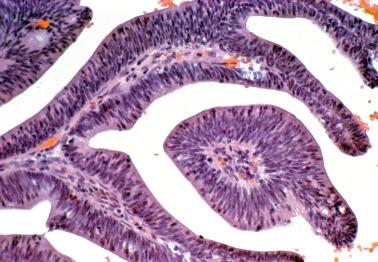
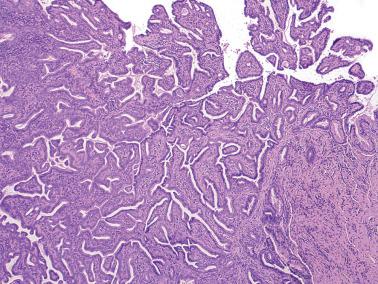
Endocervical mucinous carcinomas (EMCs) contain tumor cells with abundant cytoplasmic (and often luminal) mucin. Although some EMCs are related to HRHPV (and thus are p16+), an unknown (likely high) proportion of them are of gastric type (GTAs) and unrelated to HRHPV (Karamurzin et al., Kojima et al., Wada et al.). Minimal deviation adenocarcinomas (MDAs), a variant of gastric-type adenocarcinoma, are also considered here.
It may be difficult to determine if synchronous mucinous metaplastic or neoplastic lesions elsewhere in the FGT (endometrium, fallopian tube, ovary) are metastatic from the EMC or are independent.
Ovarian metastases may be the presenting manifestation. In such cases, the EMC may be small and superficial or noninvasive ( Chapter 18 ), suggesting direct mucosal spread. Endometrial involvement can mimic a primary endometrial mucinous carcinoma.
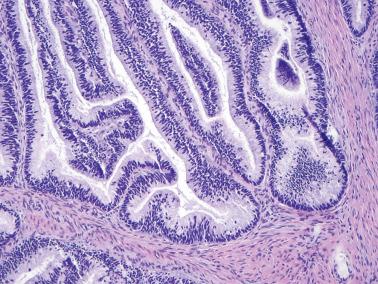
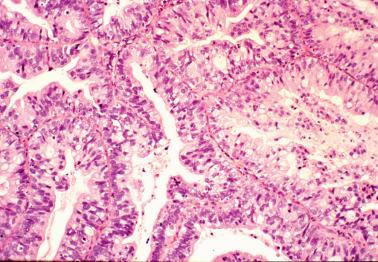
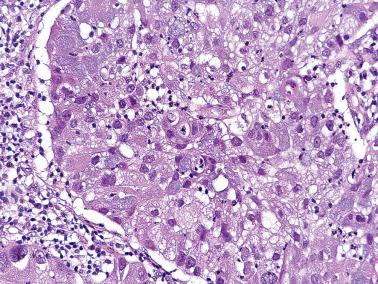
Karamurzin et al. found an age range for GTAs of 30–66 (mean, 50) years vs 40 years for those with usual EMCs. GTAs are rarely associated with the Li–Fraumeni, Peutz–Jeghers, and Lynch (HNPCC) syndromes. Pelvic examination may reveal a bulky cervix, often with an epicenter in the upper endocervix.
The neoplastic glands are lined by tall columnar cells with distinct cell borders, voluminous clear or foamy cytoplasm, and a low N:C ratio. The basal nuclei exhibit a wide range of atypia.
Wada et al. found that ~50% of GTAs contained pseudoendometrioid foci of mucin-poor cells with eosinophilic cytoplasm resembling usual-type endocervical adenocarcinomas although most such tumors were HRHPV− and thus considered bona fide GTAs. Other tumors with pseudoendometrioid foci initially interpreted as GTAs were HRHPV+ and thus reclassified as usual EMCs with a gastric type-like component. No mixed usual−gastric-type adenocarcinomas were found.
Other features can include cellular dyshesion, single cell infiltration, signet-ring cells, and intestinal-type cells (goblet cells, pyloric-type cells, Paneth-like neuroendocrine cells). Variable degrees of differentiation within one tumor, including foci of MDA, are common.
A desmoplastic stromal response is usual but can be focally minimal or absent, potentially causing underdiagnosis in a small sample; an abundant inflammatory infiltrate can be present.
Associated findings may include typical or atypical lobular endocervical glandular hyperplasia (LEGH) (a potential precursor, Chapter 4 ) and gastric-type AIS.
Immunohistochemical and molecular findings:
Carleton et al. commonly found diffuse to focal staining for CK7, MUC6, CEA, PAX8, CA125, CA19.9, HNF1β, and carbonic anhydrase IX. About half the tumors stained for CDX2 and CK20 but usually only focally; 38% were p16+ but the only two tumors with block staining were HPV−. Most tumors were negative for ER, PR, PAX2, and HER2. p53 mutational-type staining was present in ~40% of cases. Other studies have found staining for HIK1083, a pyloric mucin marker.
Mutations in the STK11 gene, a tumor suppressor gene responsible for the Peutz–Jeghers syndrome (PJS), are present in some tumors, even in those not known to be associated with the syndrome. Ito et al. found that a PJS patient had identical KRAS mutations in a GTA and contiguous atypical lobular hyperplasia.
Khan et al. found HER2 amplification in 33% of tumors, a finding with potential treatment implications.
GTAs are aggressive tumors. Karamurzin et al. found that 59% were stage II–IV (vs 11% of usual EMCs). Spread to lymph nodes, ovaries, and abdomen was found in 50%, 35%, and 20% of cases respectively. Five-year survival was 42% for GTAs (including MDA) vs 91% for usual EMCs. Similarly, Kojima et al. found a 30% 5-year survival vs 74% for usual EMCs. Even stage I GTAs are more aggressive than usual EMCs.
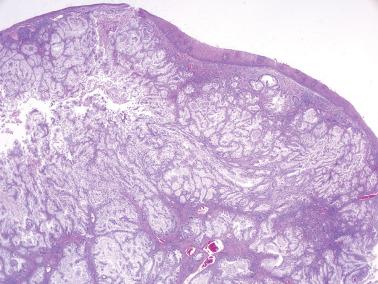
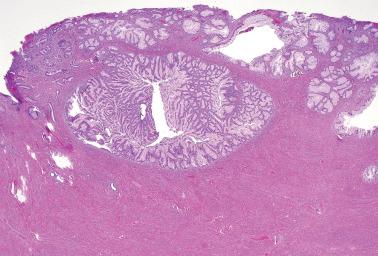
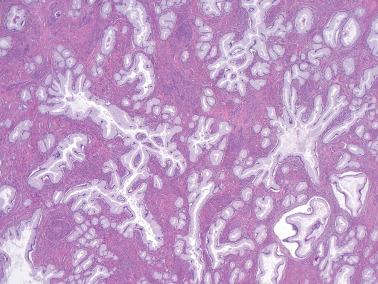
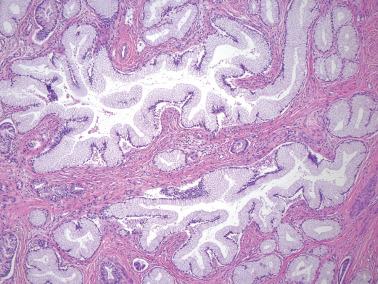
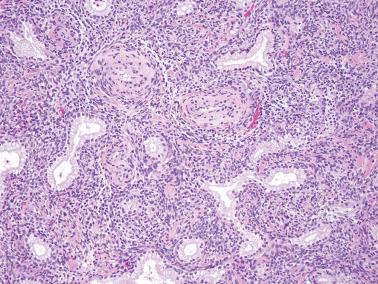
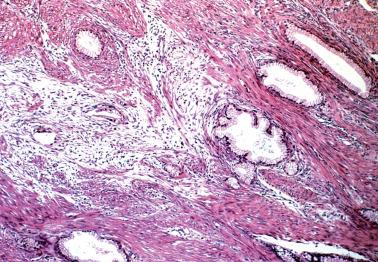
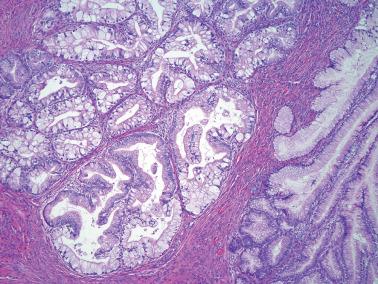

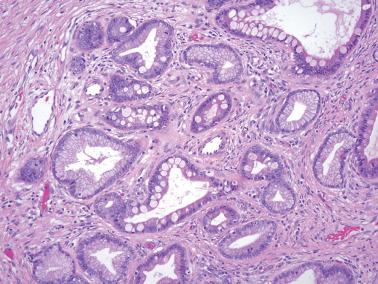

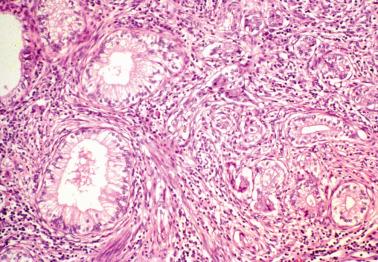
Minimal deviation adenocarcinomas (MDAs), also known as adenoma malignum, account for about a third of GTAs (see above) and 1% of cervical adenocarcinomas. MDAs may also be a pattern of usual (nongastric) mucinous carcinoma. The term refers to a well-differentiated pattern which may be subject to an erroneous benign diagnosis given its well-differentiated nature.
MDAs occur over a wide age range (mean, 42 years) and usually present with abnormal vaginal bleeding, or occasionally, a mucoid vaginal discharge. Occasional MDAs occur in patients with PJS. MDAs are aggressive tumors with a behavior similar to that of typical GTAs noted above (Karamurzin et al.).
The cervix is typically firm or indurated, with a hemorrhagic, friable or mucoid mucosal surface, and a yellow or tan–white sectioned surface. Cysts are occasionally prominent.
Microscopic findings:
The cardinal feature is a predominant component of neoplastic glands lined by deceptively benign-appearing, mucin-rich, columnar epithelial cells with basal nuclei. Occasionally, some of the glands are lined by nonspecific cuboidal cells. Mitotic figures are rare except in more poorly differentiated areas (see below).
The neoplastic glands are closely to widely spaced and highly variable in size and shape. Cystic glands, glands with papillary infolding, and lobular clustering of the glands are focal findings in occasional tumors.
A periglandular desmoplastic stromal response is present in most tumors, but is often focal. The reactive stroma, unlike normal endocervical stroma, contains SMA+/ER− myofibroblasts.
In almost all well-sampled tumors, at least some glands are lined by dysplastic to overtly malignant epithelium, and some tumors contain foci of moderately to poorly differentiated GTA.
MDAs are usually deeply invasive. Almost half the tumors have at least one of: transmural invasion, myometrial spread, or parametrial involvement. Vascular and perineural invasion is present in one-half and one-sixth of tumors, respectively.
Karamurzin et al. found associated LEGH ( Chapter 4 ) in 50% of MDAs.
Findings with special techniques:
AB/PAS staining reveals neutral cytoplasmic mucin (red staining) vs normal and hyperplastic endocervical glands that contain acid and neutral mucin (purple to blue staining).
Cytoplasmic staining for HIK1083 (a pyloric mucin marker) is usually present. Adjacent non-neoplastic glands often show pyloric metaplasia with HIK1083 (and AB/PAS) staining similar to that in the tumor.
Unlike normal endocervical epithelium, MDAs are CEA+/ER−/PR−/CA125−. CEA staining may be very focal and only strong cytoplasmic staining is diagnostically helpful in the distinction from non-neoplastic glands.
Argyrophilia is present in some tumors, a finding that may correlate with immunoreactivity for serotonin and/or peptide hormones.
HPV DNA is usually absent, even in the occasional p16+ tumors.
Mutations in the STK11 gene, a tumor suppressor gene responsible for the PJS, are present in some tumors, even in those not known to be associated with the syndrome.
Most of these rare adenocarcinomas contain intestinal-type cells including goblet, Paneth, and argentaffin cells, and occasionally a superficial villous adenoma-like component ( Chapter 4 ). Intestinal and pyloric type mucins (as in MDAs) are found in some tumors. One tumor had a pseudomyxomatous pattern of invasion (Rubio et al.).
Signet-ring cell adenocarcinomas are very rare in pure or almost pure form; some have been associated with AIS and/or contained HPV, findings supporting a cervical origin (Washimi et al.). The differential includes:
Signet-ring cells as a focal finding in typical adenocarcinomas of endocervical and mucinous types and in adenosquamous carcinomas.
Rare squamous cell carcinomas with mucin-negative signet-ring-like cells.
Signet-ring cells within clear cell carcinomas.
Metastatic signet-ring cell carcinoma to the cervix (most commonly from gastrointestinal and breast primaries) ( Chapter 10 ).
Benign signet-ring-like epithelial cells and benign signet-ring-like stromal cells secondary to cautery ( Chapter 4 ).
Colloid carcinomas are rare, and may be of intestinal-type (CDX2+/MUC2+) or endocervical type (associated AIS, HPV+, CDX2−) ( , ).
The differential also includes metastatic intestinal (usually colorectal) adenocarcinoma that should be excluded by history or clinical investigation. Endocervical intestinal-type adenocarcinomas would be expected to be CDX2+/CK7+/PAX8+/SATB2− whereas primary intestinal carcinomas are typically CDX2+/CK7−/PAX8−/SATB2+ with the exception of some CK7+ rectal adenocarcinomas.
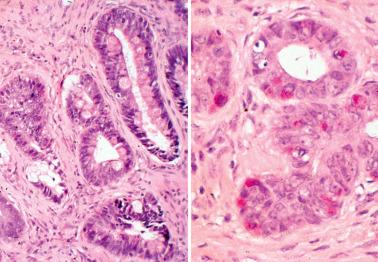
Become a Clinical Tree membership for Full access and enjoy Unlimited articles
If you are a member. Log in here